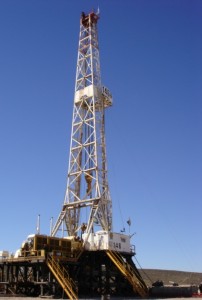With all the warnings concerning the dangers of radon gas in a residence or business flying about, it can be easy to forget some other places where exposure can happen. There are plenty of other radon hazards – or just radioactive hazards in general – around us. Many different work environments and locations across the country also pose a risk when it comes to radioactive exposure.
The National Institute for Occupational Safety and Health (NIOSH) has made it clear that there are several risks at oil and gas wells, for example. Personnel at these wells may be exposed to radioactive materials that are produced during the drilling process.
Oil and Gas Wells are Potential Radon Hazards
The phrase used to describe radiation hazards on oil and gas sites is technologically enhanced naturally occurring radioactive materials or TENORM for short. As described in the ANSI/HPS N13.53-2009 standard, the control and release of TENORM can be defined as the following:
“[A] naturally occurring radioactive material disturbed or altered from natural settings or present in a technologically enhanced state due to past or present human activities and practices, which may result in a relative increase in radionuclide concentrations, radiation exposures and risks to the public, and threat to the accessible environment above background radiation levels.”
In other words, these radioactive materials are released as the drilling equipment disturbs the soil or surrounding area. Wouldn’t you know it one of the most common substances released near a drilling site is radium, or radon gas. Radon is no joke either. It is the second leading cause of lung cancer in the United States, so it poses a severe threat to well workers and those who spend time near drilling areas. Wells in certain locations across the country produce enough radon gas to be considered one of the more serious radon hazards or health risks.
Of course, not all drills are located in areas where radioactive material is abundant. Nearly 30 percent of oil and gas wells actually produce TENORM, with the amount released varying from location to location. Wells located in states like California, Utah and Colorado are less likely to produce radioactive material. On the other hand, wells in Gulf Coast states are more likely to produce them.
Protection for Those Affected
The following steps should be taken at oil and gas wells in order to protect personnel and those who spend a significant amount of time near them:
- Those affected should understand the dangers of radioactive materials, and all associated protocols designed to minimize exposure.
- Direct skin content with radioactive equipment should be avoided, including scales.
- Eating, drinking and smoking should be prohibited in areas of the work environment where radioactive materials, equipment or even contaminated soil may be.
- Personnel should always wash after being exposed to a contaminated area. This includes washing hands and faces before eating, drinking or smoking.
- NORM-contaminated areas should be restricted to authorized personnel only.
- Potentially contaminated clothes, including undergarments should be changed when leaving the work site.
- Employees, personnel and supervisors should not bring home any materials, equipment, or supplies that may have been contaminated.
- Respirators, coveralls, gloves should be worn at all times in areas where potential exposure is possible. All equipment should be cleaned and decontaminated before being worn again.
Be Smart, Stay Safe
If you work at an oil or gas well, just remember to be smart about your health and safety and you should be fine. Ensure that you always wear the proper protection and follow the necessary rules of operation no matter how silly they may seem.
If you’d like to know more about the topic be sure to visit the source listed below.
Via: OHS Online



